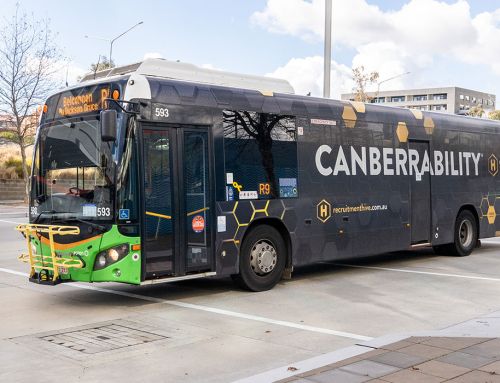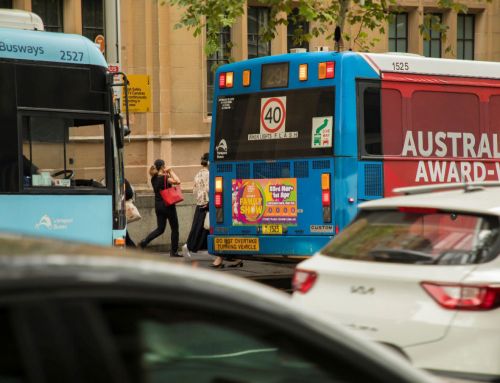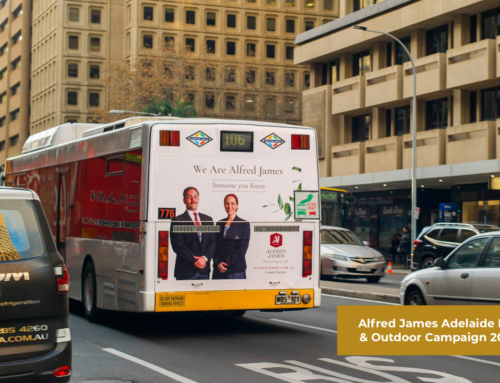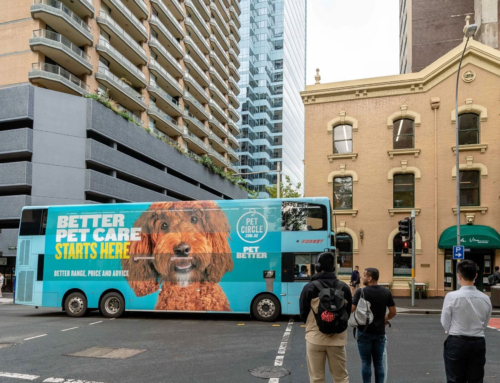Sydney’s red-and-blue buses glide through the city from dawn until the final nightlife services empty out. Every kilometre they travel turns into mobile advertising real estate that few other media can match for visibility and movement. This article unwraps the numbers behind that reach, demonstrating how a single vehicle can rack up hundreds of thousands of daily impressions and explaining why this moving canvas still matters in the digital era.
Why buses punch above their weight
A billboard sits still; a radio spot fades as soon as the jingle ends. A bus, by contrast, roams through main roads, back streets and shopping strips on the same shift. Transport for NSW records about 650 million on public transport journeys across Greater Sydney in an ordinary year, which equates to roughly 1.8 million trips on an average weekday. External audiences—drivers, pedestrians and café patrons—multiply that figure dramatically because every person outside the bus also sees the advertising.
Media planners rely on a conservative rule of thumb: each passenger view is matched by at least four external views, based on traffic counts along major corridors. With that ratio the exposure maths becomes compelling very quickly.
Crunching the daily numbers
Take Route 333, the well-known “Bondi Link” that runs from North Bondi to Circular Quay. Passenger data show the line averages about 23 000 boardings on weekdays. Double that to account for alightings and you get roughly 46 000 internal impressions—people actually inside the rolling billboard.
Apply the four-to-one external multiplier and the total climbs to:
46 000 × 4 = 184 000 external impressions
Daily total ≈ 230 000 impressions per bus in service
Even a stricter multiplier of two-to-one still leaves more than 138 000 daily exposures for a fully wrapped bus. Extend the calculation across a four-week campaign and one vehicle alone tops 4 million views.
Scaling up reveals the network effect. Deploy 25 wrapped buses across Sydney’s ten busiest routes—333, B1, 343, 373, 420 and others—and the fleet can exceed 25 million impressions in a single month, before any social media amplification or earned coverage kicks in.
Route anatomy: where geography boosts audience
Not every kilometre delivers equal value. Exposure quality hinges on where the wheels roll and when. Three corridors repeatedly top media planners’ lists:
Route | Key segments | External audience highlights |
333 Bondi–CBD | Oxford St, Bondi Rd | Shoppers, beachgoers, nightlife crowds |
B1 Dee Why–City | Pittwater Rd, Military Rd, Harbour Bridge | Commuters in peak congestion, tourists, CBD pedestrians |
420 Bondi Junction–Burwood (via airport) | General Holmes Dr, Kingsford Smith precinct, Hume Hwy | Airport staff and travellers, logistics traffic, multicultural retail strips |
Oxford Street’s footpaths rarely sit idle; Military Road spends most mornings bumper-to-bumper; and motorists on General Holmes Drive stare at tail ads while waiting for the airport lights to change. These streets turn the multiplier from theory into reality.
Frequency: the everyday reminder
Psychologists call it the mere-exposure effect: the more often people encounter a stimulus, the warmer they feel toward it. Buses bundle frequency into the timetable automatically. A commuter in Clovelly who catches the 333 daily might see the same wrap at Bondi in the morning, at Taylor Square at lunch and again creeping through Paddington after work. The message remains identical but the locations vary, a recipe for recall.
Rear-panel ads enjoy an intense, if shorter, burst of attention. Drivers stuck behind a bus at the Harbour Tunnel merge have nothing else to read for ninety seconds—an eternity compared with the three-second glance a roadside billboard receives on a 60 km/h arterial.
Interior cards bring dwell time into play. Sydney riders average about 17 minutes per trip. Eye-tracking studies show passengers glance around the cabin several times, giving interior posters multiple bites at the memory apple.
Putting the numbers in perspective
Brands often ask how bus impressions compare with digital reach. Paid social can deliver low cost-per-thousand figures, but ad-blockers and thumb-scroll fatigue erode real-world viewability. A bus wrap delivers unskippable, high-resolution artwork that towers three storeys high.
Returning to the 333 example, purchasing 4 million viewable impressions on a display network at a CPM of $5 would cost about $20 000. A four-week bus wrap may fall below or above that figure depending on design, fleet depot and duration, yet its message lives offline where attention is less fragmented. Add the inevitable social posts—tourists love snapping Bondi buses—and a slice of earned media, and the value gap widens.
The equation is not whether bus ads are cheaper than digital in isolation. It is how effectively they complement the broader mix. A smart campaign embeds a QR code or short URL on the rear panel so drivers can engage later, blending offline scale with online conversion.
Why movement matters for memory
Static billboards rely on size and colour. Buses add motion, which nudges the human brain to pay closer attention. Neuroscience experiments using EEG headgear have shown that moving outdoor ads trigger sharper spikes in attention scores than stationary counterparts, helping messages progress from fleeting glance to long-term memory. Motion plus novelty explains why wraps advertise on bus often outperform standard panels: windows transformed into a giant mural surprise onlookers, forcing a second look that sticks.
A product launch on wheels
Imagine a local coffee roaster ready to introduce its new cold-brew line city-wide. It wraps three bus advertising on Route 420 for four weeks across the summer peak. Using the earlier ratios, each bus gathers about 180 000 external impressions and 40 000 internal impressions daily.
Across 28 days the trio racks up:
(180 000 + 40 000) × 28 × 3 ≈ 18.5 million total exposures
Even if a mere 0.05 per cent of those who notice the bus shelter advertising rates Sydney later scan the QR code and buy a multipack, the campaign converts roughly 9 000 sales—enough to pay for the wraps and then some. The creative doubles as on-street sampling when brand ambassadors hand out free cans near busy stops, marrying physical presence with taste trial.
Taking the next step
Bus advertising Sydney works best when eye-catching design, precise route selection and smart timing line up. Brands that schedule wraps around retail peaks—holiday shopping, the winter sales, the spring events calendar—squeeze extra eyes out of the same spend. Reinforcing the core visual across multiple buses and, where budget allows, pairing exterior wraps with matching interior cards keeps the message consistent for riders and observers alike.
Campaign tracking should not rely on guesswork. Unique discount codes, URL parameters and geofenced mobile surveys all quantify lift, proving that the rolling billboard did more than just look good on Oxford Street.
Closing thought
Sydney’s buses operate as city-wide canvases, blanketing suburbs, the CBD and everything between. A single vehicle and bus advertising rates on the right route can tally well over 200 000 impressions in a single day, with repetition and motion multiplying the advertising effect. The result is a cost-friendly channel that marries broad reach with unavoidable visuals, delivering lasting brand lift for organisations hungry for attention in an increasingly distracted marketplace.









